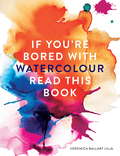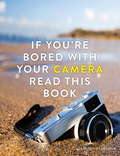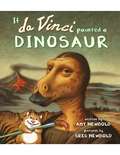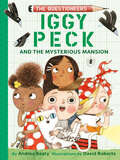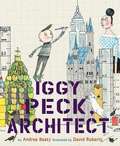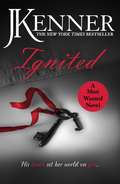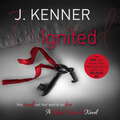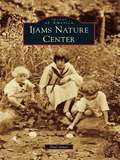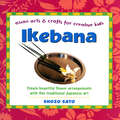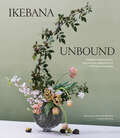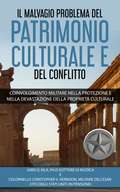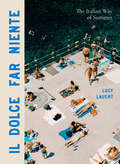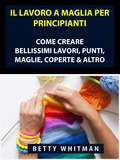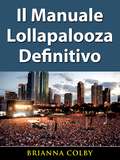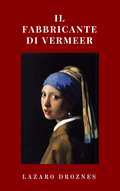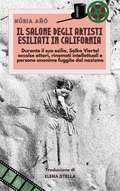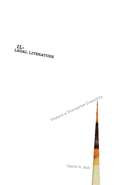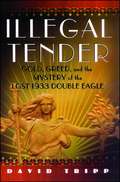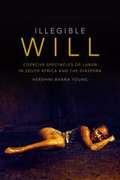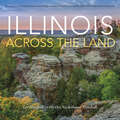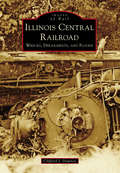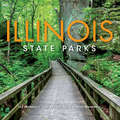- Table View
- List View
If You're Bored With WATERCOLOUR Read This Book (If you're ... Read This Book #1)
by Veronica Ballart LiljaAre you bored of painting tasteful landscapes, light seascapes and delicate still-lifes? Or are you labouring under the misconception that that is simply all watercolour is good for? Maybe you're so bored of looking at watercolour paintings that you've never even tried it! Whether you're at the beginning of your artistic journey, stuck in a rut and in desperate need of some inspiration or simply looking to improve your skills with watercolour, this book is sure to awaken your creativity. Stimulate your artistic minds and open your paint boxes to a whole new realm of possibility, using things like bleach, salt and combs - yes, the thing you'd ordinarily use to brush your hair with - to create exciting results.Professional fashion illustrator Veronica Ballart Lilja shares a wealth of new techniques based on her years of working with the medium that will open up watercolour for beginners, and encourage experts to stray from their more traditional methods. Jam packed with fresh ideas, adventurous tips and techniques, detailed theory and engaging exercises, this book allows you to develop and practise your skills in a free and expressive way.
If You're Bored With Your Camera Read This Book (If You're ... Read This Book Ser.)
by Demetrius FordhamYou know photography, don't you? Nice group pictures, tasteful landscapes, perhaps a filter from an app on your phone. Conventional, easy to manage, inoffensive, boring...right?WRONG! In this book you'll find inspiring ideas and genuinely different techniques that you can use to capture anything, from artistic portraits, through to stunning street photography and unusual aboreals. This book will open your eyes, and your lens cap, to new ideas.Topics include:Put Down Your CameraForget the RulesCreative Shooting ExercisesGo Back to Basics
If You're Bored With Your Camera Read This Book (If you're ... Read This Book #2)
by Demetrius FordhamYou know photography, don't you? Nice group pictures, tasteful landscapes, perhaps a filter from an app on your phone. Conventional, easy to manage, inoffensive, boring...right?WRONG! In this book you'll find inspiring ideas and genuinely different techniques that you can use to capture anything, from artistic portraits, through to stunning street photography and unusual aboreals. This book will open your eyes, and your lens cap, to new ideas.Topics include:Put Down Your CameraForget the RulesCreative Shooting ExercisesGo Back to Basics
If da Vinci Painted a Dinosaur
by Amy Newbold Greg NewboldA new kid-friendly tour of art history from the Newbolds In this sequel to the tour de force children’s art-history picture book If Picasso Painted a Snowman, Amy Newbold conveys nineteen artists’ styles in a few deft words, while Greg Newbold’s chameleon-like artistry shows us Edgar Degas’ dinosaur ballerinas, Cassius Coolidge’s dinosaurs playing Go Fish, Hokusai’s dinosaurs surfing a giant wave, and dinosaurs smelling flowers in Mary Cassatt’s garden; grazing in Grandma Moses’ green valley; peeking around Diego Rivera's orchids in Frida Kahlo’s portrait; tiptoeing through Baishi’s inky bamboo; and cavorting, stampeding, or hiding in canvases by Henri Matisse, Andy Warhol, Frida Kahlo, Franz Marc, Harrison Begay, Alma Thomas, Aaron Douglas, Mark Rothko, Lois Mailou Jones, Marguerite Zorach, and Edvard Munch. And, of course, striking a Mona Lisa pose for Leonardo da Vinci. As in If Picasso Painted a Snowman, our guide for this tour is an engaging beret-topped hamster who is joined in the final pages by a tiny dino artist. Thumbnail biographies of the artists identify their iconic works, completing this tour of the creative imagination.
Iggy Peck and the Mysterious Mansion (The Questioneers)
by Andrea BeatyThe New York Times–bestselling series continues with a haunted house whodunit that will take all of the Questioneers’ sleuthing skills to solve. Iggy Peck is an architect at his very core: When he’s not making houses out of food, his head is up in the clouds, dreaming of design. So he’s totally blown away when Ada Twist’s Aunt Bernice inherits an old house from ice-cream mogul Herbert Sherbert that is filled with countless rooms from all his favorite architectural periods. But something’s not quite right . . . Everyone says the house is haunted, and it seems that a number of priceless antiques—which were supposed to help Aunt Bernice pay for the house’s upkeep—have gone missing. If they can’t find those antiques, Aunt Bernice might lose the house forever. It will take all of Iggy’s knowledge of architecture and the help of the other Questioneers—Rosie Revere, Ada Twist, and Sofia Valdez—to solve the mystery and find the treasure!
Iggy Peck, Architect
by David Roberts Andrea BeatyIggy has one passion - building. His parents are proud of his fabulous creations, though they are sometimes surprised by his materials. But, when his second-grade teacher declares her dislike of his architecture, Iggy faces a challenge. He loves building too much to give it up!
Ignited: Most Wanted Book 3 (Most Wanted #Bk. 3)
by J. KennerPerfect for fans of Fifty Shades of Grey and the Crossfire series. The hot, addictive erotic romance series from the New York Times bestselling author of the Stark trilogy, of three enigmatic and powerful men, and the striking women who can bring them to their knees, concludes.He promised to take me as far as I could go - and I wanted to go to the edge. My whole life has been a cover, a con, a lie. I was raised on the thrill of playing someone I'm not. As a rule, I never let anyone get too close - until Cole August makes it impossible for me to stay away. Cole is tough, sexy, and intensely loyal, yet his secrets are dark and his scars run deep. Not many women can handle his past, or the truth behind his fierce demands. But something about him beckons me - and our desire is a game I must play. I know he's dangerous, that even his touch is trouble, but what is passion without a little risk?Don't miss the rest of the other explosive titles in the Most Wanted series: Wanted and Heated.Fall in love with J. Kenner's hot and addictive bestselling Stark series charting the romance of Nikki and Damien Stark in Release Me, Claim Me, Complete Me, Take Me, Have Me, Play My Game, Seduce Me and Unwrap Me. And follow the passionate relationship of Sylvia Brooks and Jackson Steele in the Stark International trilogy: Say My Name, On My Knees and Under My Skin.
Ignited: Most Wanted Book 3 (Most Wanted)
by J. KennerPerfect for fans of Fifty Shades of Grey and the Crossfire series. The hot, addictive erotic romance series from the New York Times bestselling author of the Stark trilogy, of three enigmatic and powerful men, and the striking women who can bring them to their knees, concludes.He promised to take me as far as I could go - and I wanted to go to the edge. My whole life has been a cover, a con, a lie. I was raised on the thrill of playing someone I'm not. As a rule, I never let anyone get too close - until Cole August makes it impossible for me to stay away. Cole is tough, sexy, and intensely loyal, yet his secrets are dark and his scars run deep. Not many women can handle his past, or the truth behind his fierce demands. But something about him beckons me - and our desire is a game I must play. I know he's dangerous, that even his touch is trouble, but what is passion without a little risk?Don't miss the rest of the other explosive titles in the Most Wanted series: Wanted and Heated.Fall in love with J. Kenner's hot and addictive bestselling Stark series charting the romance of Nikki and Damien Stark in Release Me, Claim Me, Complete Me, Take Me, Have Me, Play My Game, Seduce Me and Unwrap Me. And follow the passionate relationship of Sylvia Brooks and Jackson Steele in the Stark International trilogy: Say My Name, On My Knees and Under My Skin.(P)2014 Random House Audio
Ijams Nature Center (Images of America)
by Paul JamesIjams Nature Center, on the banks of the Tennessee River, evolved from humble beginnings during the early 20th century into a natural showplace known as the Island Home Bird Sanctuary. Developed by Harry Ijams, Knoxville's leading ornithologist, and Alice Yoe Ijams, "First Lady of Knoxville Garden Clubs," the Ijams property has been a gathering point for birders and nature-lovers for more than a century. Girl Scouting has been a fixture at Ijams since 1923, followed by Camp Mary Ijams, and Camp Margaret Townsend in the Smokies was created in part through Ijams and Townsend family ties. Harry Ijams also helped establish the first official campsite on Mount LeConte and used his artistry as a commercial illustrator to promote the Smoky Mountains as a national park. Over the years, Ijams Nature Center has grown in size and stature to become the region's leading wildlife sanctuary and environmental learning center incorporating Mead's Quarry, which in its heyday produced Tennessee marble used both in local buildings and national monuments.
Ikebana
by Shozo SatoUsing colorful illustrations this multicultural children's book introduces readers to Japanese Ikebana.Ikebana, the ancient Japanese art of flower arranging, has never been easier--or more fun! <P><P>This colorful, easy-to-follow guide will walk you through the steps of 10 different ikebana projects. Before you know it you'll be creating your very own unique and beautiful flower arrangements. Creating flower arrangements is a great way to explore this time-honored Japanese art form. <P>Following the step-by-step instructions, you'll learn to arrange how to create: <br>Kenzan Moribana--a basic style using a low, open container <br>Nageire Ikebana--formal arrangements that balance length and weight <br>Suiban (Water Platter) Ikebana--the earliest form of Ikebana, using a shallow platter filled with water <br>Natural Style Ikebana--arrangements that imitate nature <P>Once you've created your own arrangements, you can display them or give them as gifts, sharing a part of nature--and your creativity--with the people around you.About the Series:The Asian Arts & Crafts for Creative Kids series is the first series, aimed at readers ages 7-12, that provides a fun and educational introduction to Asian culture and art. Through hands on projects readers will explore each art--engaging in activities to gain a better understanding of each form.
Ikebana Unbound: A Modern Approach to the Ancient Japanese Art of Flower Arranging
by Amanda Luu Ivanka Matsuba"A modern take on a centuries-old art that’s breathtakingly simple.&”—Booklist, starred review At its heart, the Japanese art of ikebana is about celebrating an intimate connection with nature. To practice ikebana is to find inspiration in the seasons, favor unassuming blooms and branches, seek balance and simplicity, and remain fully present in the moment. It is a beautiful, pure antidote to our age of distraction and excess. Honoring the lineage of ikebana while making the art their own, Amanda Luu and Ivanka Matsuba of Studio Mondine show us new ways to tell stories with flowers. They offer step-by-step instructions for dozens of stunning, seasonal arrangements, while in the process introducing readers to the themes and stylistic signatures of the art. In Studio Mondine’s hands, this centuries-old practice feels undeniably fresh—and readers are given the gift of learning to create unique, meaningful, and authentic arrangements.
Ikebana: The Art of Arranging Flowers
by Shozo Sato Kasen YoshimuraIkebana, the Japanese art of flower arranging, is more than simply putting flowers in a container. It is a disciplined art form in which the arrangement is a living thing where nature and humanity are brought together.Ikebana: The Art of Arranging Flowers, a classic Ikebana text, has now been completely updated for modern readers. Written by Shozo Sato, a well-respected and renowned Ikebana expert, this book presents a fascinating overview of the history of Ikebana to present day, and introduces classic Ikebana styles such as Rikka, Seika and Moribana to Freestyle. The reader is familiarized with the tools of Ikebana and the basic Ikebana flower-arranging techniques. Simple and detailed instructions guide Ikebana enthusiasts through the process of making dozens of stunning arrangements.
Il Malvagio Problema Del Patrimonio Culturale E Del Conflitto: Coinvolgimento militare nella protezione e nella devastazione della Proprietà Culturale
by Joris D. Kila e Christopher V. HerndonL'eredità culturale del mondo è attualmente minacciata non solo dal tempo, dalla natura, e dallo sviluppo umano e anche dal l'aumentare dei conflitti armati. Vediamo le distruzioni causate dal saccheggio e dal traffico illecito ma anche l'iconoclastia e le manipolazioni dell'eredità culturale per motivi politici, religiosi, economici, e di propaganda. I ricavi derivati dalla vendita illecita sono spesso usati per finanziare i conflitti come illustrato nell'esempio del modello finanziario di Da'esh in questo libro. La Protezione del Patrimonio Culturale (CPP), anche se legalmente obbligatoria secondo la legge nazionale e internazionale, è mal implementata e le sanzioni sono raramente applicate. C'è però, una richiesta costante e internazionale per l'educazione e i risultati della ricerca multidisciplinare sull'argomento, specialmente nel contesto del conflitto e del crimine. Le ricerche devono includere le prospettive militari, e i meccanismi comuni collegati all’abuso e alla protezione. I risultati devono contenere concettualizzazioni accademiche, nonchè soluzioni basate sulla pratica per diminuire e mitigare i danni. Per soddisfare le richieste mentre si espandono, a seguito del loro lavoro precedente ne il Coinvolgimento Militare nella Protezione del Patrimonio Culturale: Una Panoramica (Forza Congiunta Trimestrale, JFQ 74 Joint Force Quarterly, Terzo Trimestre 2014 Luglio 2014) gli autori hanno scritto questa pubblicazione. Contiene una selezione di esempi in materia e incorpora recenti sviluppi e tendenze. Tutti gli ingredienti servono per alimentare la ricerca e il dialogo sull’uso e l’abuso dell’eredità culturale specialmente nell’evento di un conflitto, con particolare riguardo sulla cooperazione e la coordinazione tra i soggetti interessati e le parti militari. Una selezione di identificati problemi fondamentali della CPP sono disucsse come parte di un’analisi di comparazione con esempi in materia come il caso Dugongo,
Il Dolce Far Niente: The Italian Way of Summer
by Lucy LauchtThis book is a gorgeous, photographic ode to the magic of southern coastal Italy in the summer by renowned travel, fashion, and lifestyle photographer Lucy Laucht. A languorous August afternoon. That brilliant light and those impossible Mediterranean blues. The touch of sun on hot skin. And everywhere, the sounds of laughter and lighthearted conversation. Captured by photographer Lucy Laucht, these lyrical scenes of Naples, Ischia, the Amalfi Coast, Capri, Puglia, Sicily, and the Aeolian and Egadi Islands are an ode to the Italian way of summer and that distinctly Italian art of sweet idleness.
Il Lavoro a Maglia per Principianti: Come Creare Bellissimi Lavori, Punti, Maglie, Coperte & Altro
by Betty WhitmanTi piace lavorare a maglia o vorresti imparare come si fa? Impara a creare bellissimi progetti in pochissimo tempo" Che tu sia per strada, a casa, o in qualsiasi altro luogo, puoi lavorare all'uncinetto nel tempo libero, dovunque tu voglia. - Crea dei progetti in soltanto poche ore. - Impara a lavorare all'uncinetto. - Impara lo schema dei punti. - Crea cappelli, maglioni, calzini, regali, oggetti per la casa, e molto altro! >>> Ordina La Tua Copia Immediatamente
Il Manuale Completo ai Dispositivi Roku: TV, Express, Ultra, Stick, Canali, Applicazioni, Account
by Hiddenstuff EntertainmentUna guida passo passo su come ottenere il massimo dai tuoi dispositivi Roku *Utilizzabile con tutti i dispositivi Roku* Le massime capacità dei dispositivi Roku non sono tutti i suoi canali e le sue funzioni. Impara ad utilizzare i tuoi dispositivi al massimo, come fanno i professionisti. Ecco cosa avrai: -App -Menù -Canali -Show, tv e musica -Impostare il dispositivo -Opzioni -Aggiornamenti -Risoluzione dei problemi -Impostazioni del display + MOLTO ALTRO! --> Vai in cima alla pagina e clicca su aggiungi al carrello per acquistarlo immediatamente Disclaimer: This author and or rights owner(s) make no claims, promises, or guarantees about the accuracy, completeness, or adequacy of the contents of this book, and expressly disclaims liability for errors and omissions in the contents within. This product is for reference use only.
Il Manuale Lollapalooza Definitivo
by Brianna ColbyChe tu sia nuovo o un veterano, questo manuale ha i consigli che ti serviranno per sopravvivere e vivere bene uno dei più meravigliosi festival di tutti i tempi! Il Loolapalooza continua ad essere una delle esperienze di festival più fantastiche che le persone abbiano mai fatto. Comunque ci sono molti consigli e trucchi che devi imparare per trarre il meglio da questa esperienza. Questo manuale ti insegnerà le cose da fare e non fare in questo festival, oltre a risparmiare denaro e divertirti allo stesso tempo! - Tipologie di biglietto & come risparmiare soldi - Risparmiare sui biglietti - Linee aeree e sconti - Alberghi e sconti - Come massimizzare la tua esperienza - Cosa portare e cosa lasciare a casa --> Vai in cima alla pagina e clicca su aggiungi al carrello per acquistare immediatamente Disclaimer: This author and or rights owner(s) make no claims, promises, or guarantees in regards to the accuracy, completeness, or adequacy of the contents of this book, and expressly disclaims liability for errors and omissions in the contents within. This product is for reference use only. Please consult a professional before taking action on any of the contents found within.
Il fabbricante di Vermeer
by Lazaro DroznesHans van Meegeren fu un pittore olandese che durante la Seconda Guerra Mondiale produsse dei Vermeer migliori di quelli originali, riuscì a ingannare l'intera comunità artistica e lo stesso Herman Göring, e alla fine dovette confessare la sua contraffazione per salvarsi dalla pena di morte. Questa opera teatrale si basa sull'incredibile storia di Hans van Meegeren che negli anni '30 e durante la Seconda Guerra Mondiale, riuscì a falsificare e vendere 6 Vermeer e due Franz Hals per un importo di circa100 milioni di dollari attuali. Uno dei Vermeers fu acquistato da Herman Göring, secondo nella gerarchia del Terzo Reich. Alla fine della Seconda Guerra Mondiale, Van Meegeren ha dovette rispondere dell'accusa di essere un traditore del paese e dovette confessare la sua contraffazione per salvarsi la vita. Queste confessioni provocarono un terremoto nella comunità artistica olandese a e nel mondo intero, perchè i suoi falsi erano stati accettati all'unanimità, e uno in particolare, il Cristo in Emmaus era considerato il miglior Vermeer di sempre. Questo dramma scenico, basato su eventi reali, ci porta a riflettere sul concetto di autenticità nell'arte e sulla validità dei concetti tradizionali di verità e bellezza. Un dipinto cessa di essere bello quando si dimostra essere un falso?
Il salone degli artisti esiliati in California
by Núria AñóIl salone degli artisti esiliati in California è una biografia di Salka Viertel, un’attrice ebrea che emigrò a Hollywood e fu popolarmente conosciuta come la sceneggiatrice dell’attrice svedese Greta Garbo. Inoltre, era proprietaria di un salone a Santa Monica (California), frequentato da molti intellettuali europei in esilio. Salka Viertel fu una donna molto moderna e singolare che si merita un riconoscimento. Nel libro affiorano temi come la presunta bisessualità di Salka Viertel e la quantità di amici rinomati che aveva, per citarne qualcuno Albert Einstein, Charles Chaplin, Sergei Eisenstein, F. W. Murnau, Max Reinhardt, Arnold Schönberg, Thomas Mann, Bertolt Brecht, Greta Garbo, Montgomery Clift... Come Gertrude Stein e altre donne celebri, possedeva un salone letterario per il quale passarono molti scrittori, tra cui Truman Capote, Christopher Isherwood, Gore Vidal e molti altri. Altri temi che troviamo sono la Berlino degli anni’20; il passaggio dal cinema muto a quello parlato visto dalla mecca di Hollywood; l’ascesa di Hitler e le conseguenze che ebbe per il popolo ebraico; l’esilio di intellettuali che non potevano tornare ai loro paesi a causa della Seconda guerra mondiale; la Guerra fredda e la caccia alle streghe contro il comunismo. Lo sfondo della vita di Salka Viertel e della sua cerchia di amici comprende i grandi eventi del XX secolo. Grazie a questo progetto, l’autrice ha ottenuto le borse di soggiorno SWP (Cina, 2016) e BCWT (Svezia, 2017). "Lo considero un racconto molto interessante e ancora molto attuale ai giorni nostri, dato che ai miei occhi non abbiamo fatto molti progressi nella questione di accettazione dei “sentimenti interpersonali” in generale. Un grande libro, estremamente interessante, sull’Hollywood degli anni’30 e’40 e l’influenza di artisti da paesi europei come Germania, Aust
Illegal Literature: Toward a Disruptive Creativity
by David S. RohWhat is the cultural value of illegal works that violate the copyrights of popular fiction? Why do they persist despite clear and stringent intellectual property laws? Drawing on the disciplines of new media, law, and literary studies, Illegal Literature suggests that extralegal works such as fan fiction are critical to a system that spurs the evolution of culture.Reconsidering voices relegated to the cultural periphery, David S. Roh shows how infrastructure—in the form of legal policy and network distribution—slows or accelerates the rate of change. He analyzes the relationship between intellectual property rights and American literature in two recent copyright disputes. And, in comparing American fan fiction and Japanese dojinshi, he illustrates how infrastructure and legal climates detract from or encourage fledgling creativity.Illegal Literature fills a crucial gap between the scholarly and the popular by closely examining several modes of marginalized cultural production. Roh makes the case for protecting an environment conducive to literary heresy, the articulation of an accretive rather than solitary authorial genius, and the idea that letting go rather than holding on is important to a generative creative process. In a media ecology inundated by unauthorized materials, Illegal Literature argues that the proliferation of unsanctioned texts may actually benefit literary and cultural development.
Illegal Tender: Gold, Greed, and the Mystery of the Lost 1933 Double Eagle
by David TrippIt's the most valuable ounce of gold in the world, the celebrated, the fabled, the infamous 1933 double eagle, illegal to own and coveted all the more, sought with passion by men of wealth and with steely persistence by the United States government for more than a half century—it shouldn't even exist but it does, and its astonishing, true adventures read like "a composite of The Lord of the Rings and The Maltese Falcon" (The New York Times). In 1905, at the height of the exuberant Gilded Age, President Theodore Roosevelt commissioned America's greatest sculptor, Augustus Saint-Gaudens—as he battled in vain for his life—to create what became America's most beautiful coin. In 1933 the hopes of America dimmed in the darkness of the Great Depression, and gold—the nation's lifeblood—hemorrhaged from the financial system. As the economy teetered on the brink of total collapse, Franklin Delano Roosevelt, in his first act as president, assumed wartime powers while the nation was at peace and in a "swift, staccato action" unprecedented in United States history recalled all gold and banned its private ownership. But the United States Mint continued, quite legally, to strike nearly a half million 1933 double eagles that were never issued and were deemed illegal to own. In 1937, along with countless millions of other gold coins, they were melted down into faceless gold bars and sent to Fort Knox. The government thought they had destroyed them all—but they were wrong. A few escaped, purloined in a crime—an inside job—that wasn't discovered until 1944. Then, the fugitive 1933 double eagles became the focus of a relentless Secret Service investigation spearheaded by the man who had put away Al Capone. All the coins that could be found were seized and destroyed. But one was beyond their reach, in a king's collection in Egypt, where it survived a world war, a revolution, and a coup, only to be lost again. In 1996, more than forty years later, in a dramatic sting operation set up by a Secret Service informant at the Waldorf-Astoria, an English and an American coin dealer were arrested with a 1933 double eagle which, after years of litigation, was sold in July 2002 to an anonymous buyer for more than $7.5 million in a record-shattering auction. But was it the only one? The lost one? Illegal Tender, revealing information available for the first time, tells a riveting tale of American history, liberally spiced with greed, intrigue, deception, and controversy as it follows the once secret odyssey of this fabulous golden object through the decades. With its cast of kings, presidents, government agents, shadowy dealers, and crooks, Illegal Tender will keep readers guessing about this incomparable disk of gold—the coin that shouldn't be and almost wasn't—until the very end.
Illegible Will: Coercive Spectacles of Labor in South Africa and the Diaspora
by Hershini Bhana YoungIn Illegible Will Hershini Bhana Young engages with the archive of South African and black diasporic performance to examine the absence of black women's will from that archive. Young argues for that will's illegibility, given the paucity of materials outlining the agency of black historical subjects. Drawing on court documents, novels, photographs, historical records, websites, and descriptions of music and dance, Young shows how black will can be conjured through critical imaginings done in concert with historical research. She critically imagines the will of familiar subjects such as Sarah Baartman and that of obscure figures such as the eighteenth-century slave Tryntjie of Madagascar, who was executed in 1713 for attempting to poison her mistress. She also investigates the presence of will in contemporary expressive culture, such as the Miss Landmine Angola beauty pageant, placing it in the long genealogy of the freak show. In these capacious case studies Young situates South African performance within African diasporic circuits of meaning throughout Africa, North America, and South Asia, demonstrating how performative engagement with archival absence can locate that which was never recorded.
Illinois Across the Land
by Lee Mandrell DeeDee Niederhouse-MandrellWhether you find beauty in a remote forest or a sparkling nighttime cityscape, Illinois offers jaw-dropping scenery and opportunities for adventure with stunning landscapes, natural wonders, small town charms, and big city thrills. Join photographers Lee Mandrell and DeeDee Niederhouse-Mandrell on a visual journey across the Prairie state, as they travel from the beaches of Lake Michigan over rolling forested hills and picturesque farmland, through covered bridges, past historic barns and windmills, and up to the edge of the awe-inspiring rocky cliffs of the Garden of the Gods.Featuring more than 140 gorgeous photos, Illinois Across the Land inspires travelers to explore the state and discover historic landmarks at the Lincoln Log Cabin State Historical Site, rushing waterfalls in Starved Rock State Park, native wildlife in Crab Orchard Wildlife Refuge, breathtaking sunsets at Carlyle Lake, and so much more!
Illinois Central Railroad: Wrecks, Derailments, and Floods (Images of Rail)
by Clifford J. DowneyWith roots dating back to 1851, the Illinois Central Railroad (IC) transported millions of passengers and countless tons of freight. Most trips were completed without incident. However, there were occasional mishaps, including derailments and collisions with other trains or highway vehicles. Most accidents were minor, while others made the national news, such as the October 30, 1972, collision of two commuter trains in Chicago that killed 45 passengers. The IC frequently had to deal with flooding, for the railroad ran in close proximity to several major rivers. In January and February 1937, much of the southern half of the railroad was shut down because of flooding on the Ohio and Mississippi Rivers. This book depicts many of the accidents that have taken place along the Illinois Central through the years. The photographs are drawn from numerous sources, including the railroad's own photographers, amateur photographers, and photography studios.
Illinois State Parks
by Lee Mandrell DeeDee Niederhouse-MandrellDiscover the breathtaking beauty and unforgettable adventures that await in Illinois state parks. Lee Mandrell and DeeDee Niederhouse-Mandrell highlight the incredible diversity and natural beauty of the landscapes, flora, and fauna of the state. Marvel at the unique rock formations and 55 foot opening at Cave-In-Rock State Park, or leave the land behind to explore the waterways at Chain O’ Lakes State Park. Step into history at Fort Massac State Park, or sit back and enjoy a striking sunset over the cypress grove at Eldon Hazlet State Park, Illinois’ largest campground. Just in time for the state bicentennial, Illinois State Parks brings together more than 130 gorgeous full-color photographs highlighting some of the most beautiful and popular state parks in Illinois.
